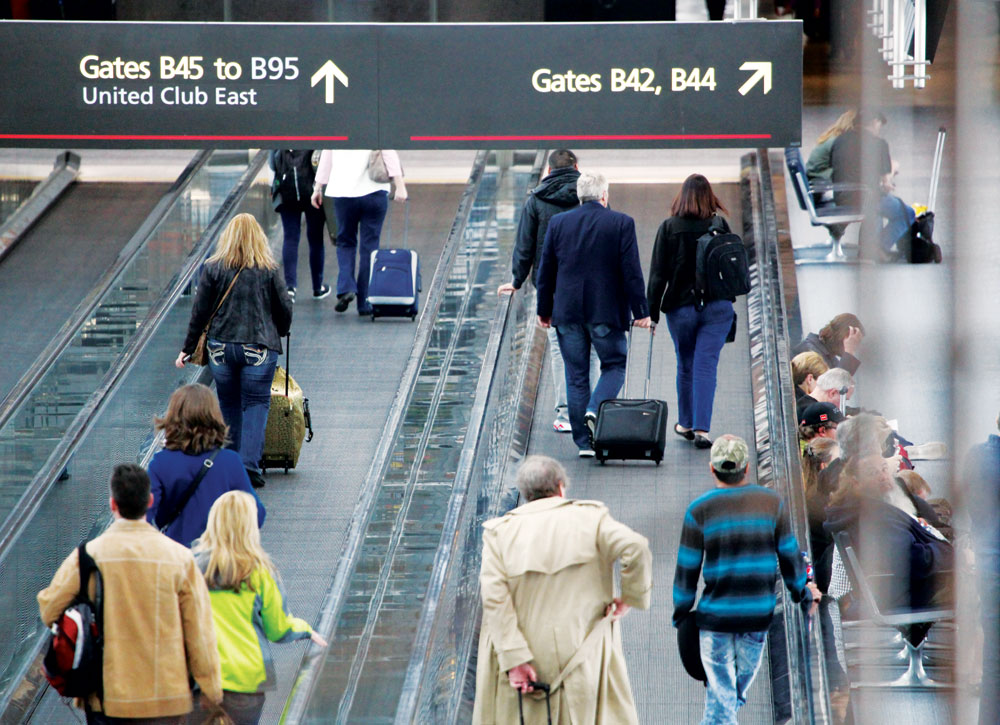

Without thinking twice, many people use elevators, escalators and moving walkways like those at DIA, but how safe are they? Photo courtesy of DIA
Every week it seems there’s a new video of someone being mauled by an escalator. And not just in China. Back in 2003, an escalator malfunctioned at our very own Coors Field, injuring dozens. Yet today, there are even more escalators than ever before. Does that mean we should all take the stairs?
And elevators? They define our skylines. Think about it—how did cities look before we were able to quickly whisk people from bottom to top of skyscrapers? Nobody wanted a 30-story walk-up to their office or apartment, so buildings were shorter before safe elevators became de rigueur.
What about moving walkways? They foster the growth and prolific size of airports, malls, etc. Witness DIA, the largest U.S. airport, where moving walkways allow large numbers of people to be whisked between ever-farther terminals.
Every day millions of us get onto these devices without a second thought. How safe are they?
It depends. Antiquated Colorado conveyances (a.k.a. escalators, elevators, and people-movers) are essentially “grandfathered in” such that their safety approaches can be as old as they are. Older equipment often lacks advanced automatic sensors to detect problems and safely shut down machinery. But the good news is that regulation of equipment is becoming more rigorous. For example, soon after the Coors Field incident, a law was passed to enable the state of Colorado to take over regulation of conveyances, requiring them to be registered and inspected for safety every year by an independent third party.
Many accidents result from user error, often in tandem with equipment idiosyncrasies. For example, a Texas doctor presumed the elevator doors’ safety edge would do the job for him—seems his hands were full and he tried to use his head to stop the doors in the elevator. The end result was his head, lacking the rest of his body, ended up on the floors above. This tragedy might not occur on a new elevator—all of which have full-height electronic edge detectors (imagine 80 of those infrared garage-door “eyes” lining the elevator door). Many older elevators only have a safety edge controlled by pressure sensitivity and antiquated relay logic controllers, sometimes paired with one or two infrared sensors at the bottom of the doors. These foot-level sensors wouldn’t detect a head in the door, and a head might be too narrow to trigger an adjusted-too-wide relay logic controller.
Elevators in buildings over seven stories move using a cable-driven counterbalance weight system, which means that they use their brakes to keep the car from rocketing upward too quickly. The thing about these elevators is that they usually fall upward and can do so quickly in a herky-jerky fashion if the brakes are released or when the elevator’s electronic controller “finds” the elevator and decides to move it. That’s why the most dangerous thing you can do if an elevator is stuck is to try to exit it or pry your way out—many an escapee from a stuck elevator has been chopped in half by a sudden upward lurching of the elevator.
New escalators are also stocked with game-changing safety technology. They have sensors in the steps that shut down the ride if they are tilted or encounter too much drag—say if your foot got stuck between them and the escalator’s comb plate. They can sense if the skirt, that fuzzy-edged vertical metal piece that borders the left and right side of the steps, is dislodged enough to create a gap. Ditto if the comb plate (the plate that you step over as you exit) is lifted by a foot, bag, or other object. That said, there are plenty of older escalators out there, and accidents can even happen on newfangled ones when we’re not paying attention. Like the kids sitting on New Jersey escalator steps whose extremities were mangled while their parents chatted on their mobile phones. If you do see someone having a problem on an escalator, don’t hesitate to push the bright-red stop button that’s located near the handrail at the entry or exit of the escalator.
Conveyances like these permit greater mobility and offer increasingly safe improvements to our infrastructural efficiency. They’re more space and energy-efficient—some even employ regenerative braking systems that produce electricity like a Prius. And there will be more of these devices in our lives because ADA requirements essentially force their installation into new multistory public and commercial buildings.
But like any suite of tools, some are safer than others and it’s worth paying attention when using them.
James Hagadorn, Ph.D., is a scientist at the Denver Museum of Nature & Science. Suggestions and comments are welcome at jwhagadorn@dmns.org.


I found your articles in “Front Page Stapleton”. Thanks for talking with me. Good luck on Sherlock Holmes.
Richard Crabb